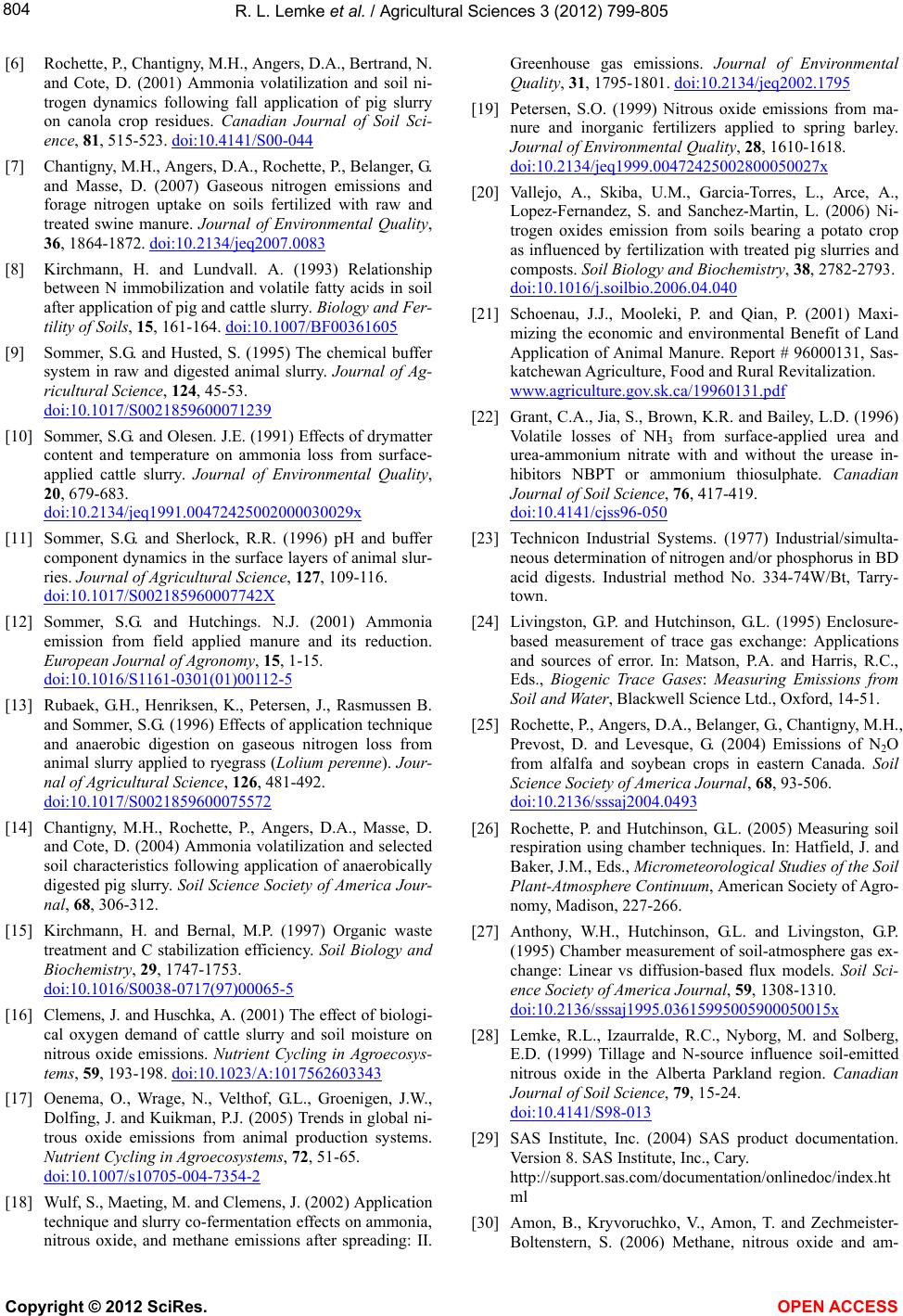
R. L. Lemke et al. / Agricultural Sciences 3 (2012) 799-805
804
[6] Rochette, P., Chantigny, M.H., Angers, D.A., Bertrand, N.
and Cote, D. (2001) Ammonia volatilization and soil ni-
trogen dynamics following fall application of pig slurry
on canola crop residues. Canadian Journal of Soil Sci-
ence, 81, 515-523. doi:10.4141/S00-044
[7] Chantigny, M.H., Angers, D.A., Rochette, P., Belanger, G.
and Masse, D. (2007) Gaseous nitrogen emissions and
forage nitrogen uptake on soils fertilized with raw and
treated swine manure. Journal of Environmental Quality,
36, 1864-1872. doi:10.2134/jeq2007.0083
[8] Kirchmann, H. and Lundvall. A. (1993) Relationship
between N immobilization and volatile fatty acids in soil
after application of pig and cattle slurry. Biology and Fer-
tility of Soils, 15, 161-164. doi:10.1007/BF00361605
[9] Sommer, S.G. and Husted, S. (1995) The chemical buffer
system in raw and digested animal slurry. Journal of Ag-
ricultural Science, 124, 45-53.
doi:10.1017/S0021859600071239
[10] Sommer, S.G. and Olesen. J.E. (1991) Effects of drymatter
content and temperature on ammonia loss from surface-
applied cattle slurry. Journal of Environmental Quality,
20, 679-683.
doi:10.2134/jeq1991.00472425002000030029x
[11] Sommer, S.G. and Sherlock, R.R. (1996) pH and buffer
component dynamics in the surface layers of animal slur-
ries. Journal of Agricultural Science, 127, 109-116.
doi:10.1017/S002185960007742X
[12] Sommer, S.G. and Hutchings. N.J. (2001) Ammonia
emission from field applied manure and its reduction.
European Journal of Agronomy, 15, 1-15.
doi:10.1016/S1161-0301(01)00112-5
[13] Rubaek, G.H., Henriksen, K., Petersen, J., Rasmussen B.
and Sommer, S.G. (1996) Effects of application technique
and anaerobic digestion on gaseous nitrogen loss from
animal slurry applied to ryegrass (Lolium perenne). Jour-
nal of Agricultural Science, 126, 481-492.
doi:10.1017/S0021859600075572
[14] Chantigny, M.H., Rochette, P., Angers, D.A., Masse, D.
and Cote, D. (2004) Ammonia volatilization and selected
soil characteristics following application of anaerobically
digested pig slurry. Soil Science Society of America Jour-
nal, 68, 306-312.
[15] Kirchmann, H. and Bernal, M.P. (1997) Organic waste
treatment and C stabilization efficiency. Soil Biology and
Biochemistry, 29, 1747-1753.
doi:10.1016/S0038-0717(97)00065-5
[16] Clemens, J. and Huschka, A. (2001) The effect of biologi-
cal oxygen demand of cattle slurry and soil moisture on
nitrous oxide emissions. Nutrient Cycling in Agroecosys-
tems, 59, 193-198. doi:10.1023/A:1017562603343
[17] Oenema, O., Wrage, N., Velthof, G.L., Groenigen, J.W.,
Dolfing, J. and Kuikman, P.J. (2005) Trends in global ni-
trous oxide emissions from animal production systems.
Nutrient Cycling in Agroecosystems, 72, 51-65.
doi:10.1007/s10705-004-7354-2
[18] Wulf, S., Maeting, M. and Clemens, J. (2002) Application
technique and slurry co-fermentation effects on ammonia,
nitrous oxide, and methane emissions after spreading: II.
Greenhouse gas emissions. Journal of Environmental
Quality, 31, 1795-1801. doi:10.2134/jeq2002.1795
[19] Petersen, S.O. (1999) Nitrous oxide emissions from ma-
nure and inorganic fertilizers applied to spring barley.
Journal of Environmental Quality, 28, 1610-1618.
doi:10.2134/jeq1999.00472425002800050027x
[20] Vallejo, A., Skiba, U.M., Garcia-Torres, L., Arce, A.,
Lopez-Fernandez, S. and Sanchez-Martin, L. (2006) Ni-
trogen oxides emission from soils bearing a potato crop
as influenced by fertilization with treated pig slurries and
composts. Soil Biology and Biochemistry, 38, 2782-2793.
doi:10.1016/j.soilbio.2006.04.040
[21] Schoenau, J.J., Mooleki, P. and Qian, P. (2001) Maxi-
mizing the economic and environmental Benefit of Land
Application of Animal Manure. Report # 96000131, Sas-
katchewan Agriculture, Food and Rural Revitalization.
www.agriculture.gov.sk.ca/19960131.pdf
[22] Grant, C.A., Jia, S., Brown, K.R. and Bailey, L.D. (1996)
Volatile losses of NH3 from surface-applied urea and
urea-ammonium nitrate with and without the urease in-
hibitors NBPT or ammonium thiosulphate. Canadian
Journal of Soil Science, 76, 417-419.
doi:10.4141/cjss96-050
[23] Technicon Industrial Systems. (1977) Industrial/simulta-
neous determination of nitrogen and/or phosphorus in BD
acid digests. Industrial method No. 334-74W/Bt, Tarry-
town.
[24] Livingston, G.P. and Hutchinson, G.L. (1995) Enclosure-
based measurement of trace gas exchange: Applications
and sources of error. In: Matson, P.A. and Harris, R.C.,
Eds., Biogenic Trace Gases: Measuring Emissions from
Soil and Water, Blackwell Science Ltd., Oxford, 14-51.
[25] Rochette, P., Angers, D.A., Belanger, G., Chantigny, M.H.,
Prevost, D. and Levesque, G. (2004) Emissions of N2O
from alfalfa and soybean crops in eastern Canada. Soil
Science Society of America Journal, 68, 93-506.
doi:10.2136/sssaj2004.0493
[26] Rochette, P. and Hutchinson, G.L. (2005) Measuring soil
respiration using chamber techniques. In: Hatfield, J. and
Baker, J.M., Eds., Micrometeorological Studies of the Soil
Plant-Atmosphere Continuum, American Society of Agro-
nomy, Madison, 227-266.
[27] Anthony, W.H., Hutchinson, G.L. and Livingston, G.P.
(1995) Chamber measurement of soil-atmosphere gas ex-
change: Linear vs diffusion-based flux models. Soil Sci-
ence Society of America Journal, 59, 1308-1310.
doi:10.2136/sssaj1995.03615995005900050015x
[28] Lemke, R.L., Izaurralde, R.C., Nyborg, M. and Solberg,
E.D. (1999) Tillage and N-source influence soil-emitted
nitrous oxide in the Alberta Parkland region. Canadian
Journal of Soil Science, 79, 15-24.
doi:10.4141/S98-013
[29] SAS Institute, Inc. (2004) SAS product documentation.
Version 8. SAS Institute, Inc., Cary.
http://support.sas.com/documentation/onlinedoc/index.ht
ml
[30] Amon, B., Kryvoruchko, V., Amon, T. and Zechmeister-
Boltenstern, S. (2006) Methane, nitrous oxide and am-
Copyright © 2012 SciRes. OPEN ACCESS